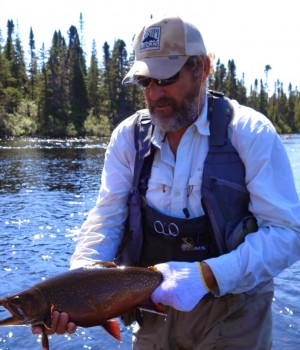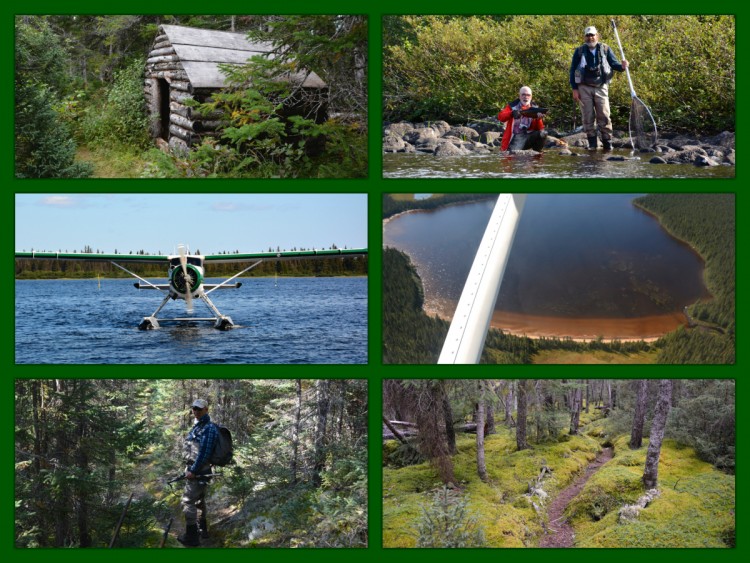 When you picture a perfect day of fly-fishing, what do you envision? Do you catch lots of fish? Few but primarily large fish? Do you imagine trekking trails to find a secret spot that no one has been to before, or do you picture a leisurely spot that has been tested and proven fruitful over many years?
When you picture a perfect day of fly-fishing, what do you envision? Do you catch lots of fish? Few but primarily large fish? Do you imagine trekking trails to find a secret spot that no one has been to before, or do you picture a leisurely spot that has been tested and proven fruitful over many years?
Like many of our anglers, we’re guessing that exploring new and yet-untouched lakes and rivers might be what you’re looking for.
Previous guests Duncan Lewis and Howard Guptill have told us of spots that, to their knowledge and their guides knowledge, had never been fished before. Lakes shaped like hearts, some spots only 3-4 feet deep teeming with brook trout that anxiously snatch flies the second they hit the water. Not all huge fish, but lots and lots of fish.
The heart shaped lake that proved fruitful for one guest claims, “It can’t be too far from the Kenamu River, it was an adventure. We saw the remains of trappers’ camps, not recent, and remains of an old canoe.”
Even our guides, some of whom have been with us for over 30 years, have said that there’s much to the Minipi Watershed that still remains unexplored.
“You should note that Big Hairy Lake itself is some 12 miles, or 19 kilometers long,” says guide Ralph Coles.
The Minipi Watershed covers a generous portion of south-central Labrador, it’s an area where one cannot travel far without needing a canoe to continue their journey. One of the more popular fishing locales for Coopers’ guests, Minipi Lake, stretches 35 miles – from Black Fly inlet in the southeast to the Outlet, the Gorge and Minipi Lodge in the northwest.

Channeling his inner Lee Wulff, our beaver pilot Chris Woodward has the adventure bug. Chris is always hoping for that one guest who’s not afraid to fly the extra mile into the wild for what could be the ‘big one.’
“We are always looking for some new places to go on a fly out,” says Chris, “The best thing is to sit down with (head guide) Ray and I the day before and decide if you want to go to the places we know are great like Little Minipi and Big Minipi, or take a chance on somewhere new. Who knows it might be great or not so great, but that’s all part of the adventure isn’t it?”
In this excerpt from an interview last season, Minipi veteran Duncan Lewis recalls finding what guests now know as Black Duck drainage:
People had flown over these lakes in float plane because it’s the route between Minipi and Anne Marie, they would say they could look out the window and see fish rising in a couple of big lakes up there. There were enough stories about the fish rising that one day when there was nothing going on, Howard and I decided we would go over and have a look. I’m going to say we were the first ones, at least in the Coopers’ time frame, to walk in there. Howard is a real woodsman. We got as far as we could in the water and then we took off through the woods. He picked up on an old trappers trail – it looked just like all of the other woods to me but he said it was a trappers trail and we followed all the way through to the landing spot at the other drainage where we found a nice plunge pool. There were no hatches or anything going on at that time so we took out the gas stove and made tea. We sat there long enough that the hatch started and it turned out to be a wonderful fishing event. We caught great big ones, turned out to be quite a few of them (trout). That peaked our interest of course and we ended up cutting some trail.
When Lee Wulff discovered Minipi in the 50s, he had a vision of keeping its waters and all the fish that called it home, safe. This upcoming fishing season will be our 38th year, and the fishing today is as good if not better because we’ve followed through with Lee’s wishes. There is much left to discover within the boundaries of the giant Minipi Watershed, we’re looking forward to finding out what’s ahead.
For more on our named fishing locations, click here. To make your own discoveries, give us a call.



